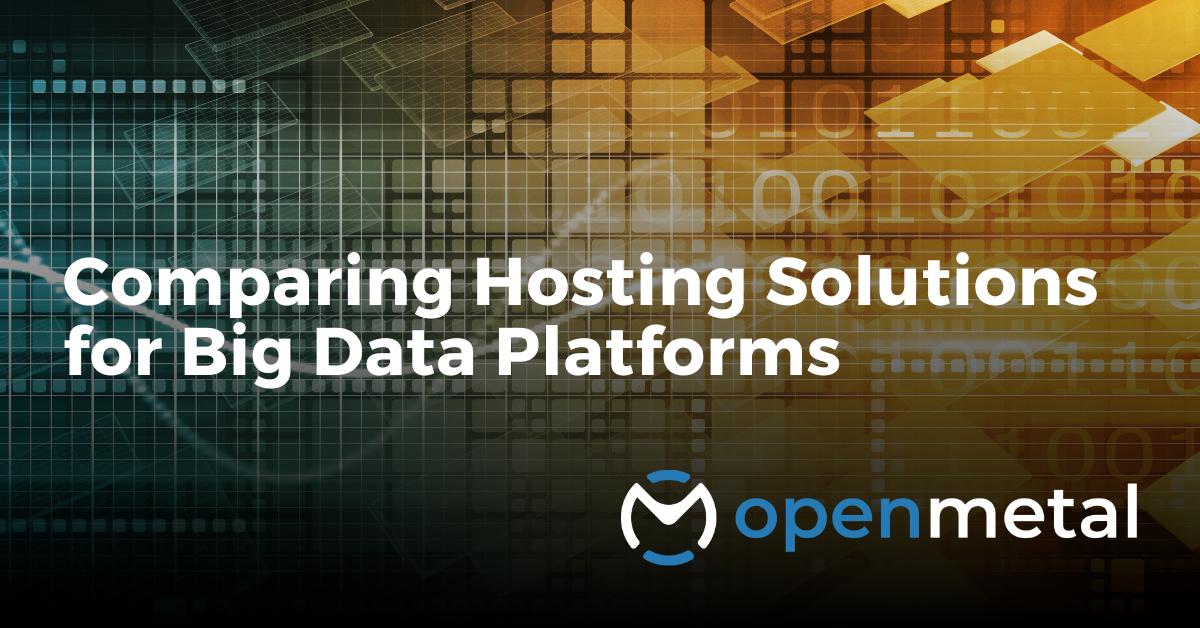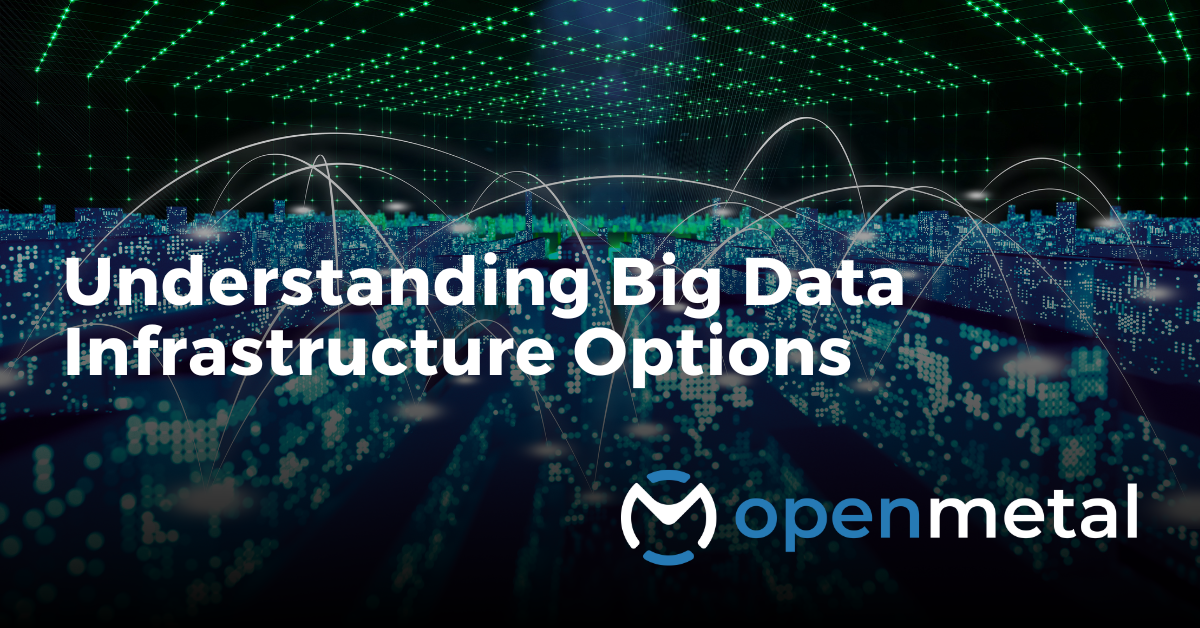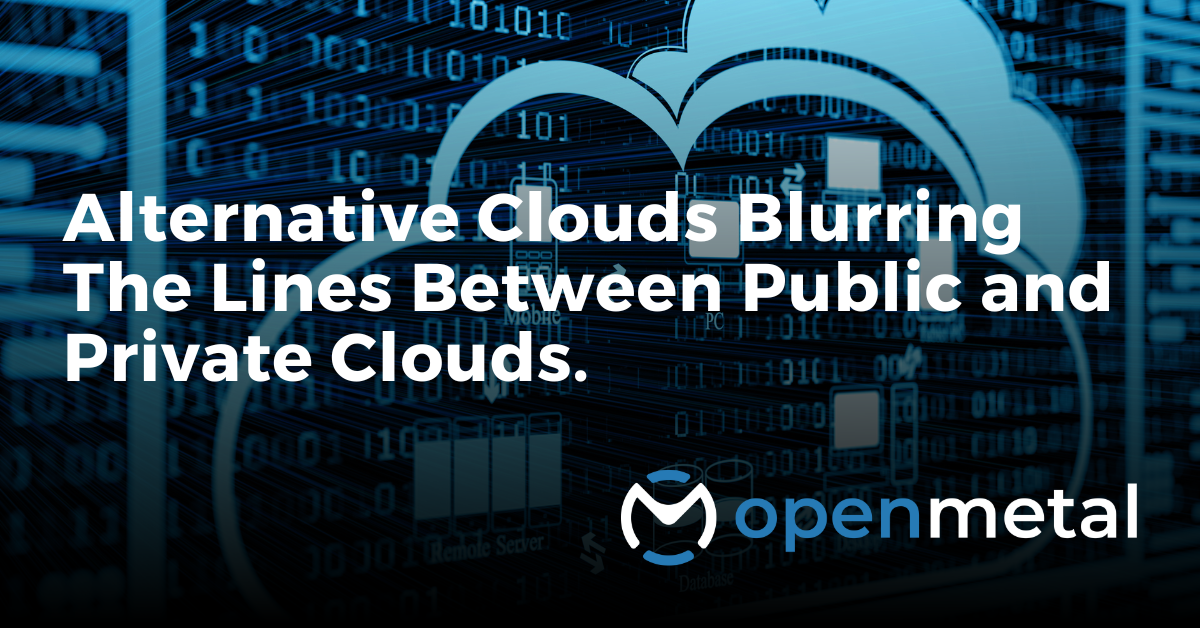In a previous article, Understanding Big Data Infrastructure Options, we defined big data (at a high level), big data platforms, and introduced infrastructure options that can be used to support those platforms. This article evaluates and compares different big data hosting options to support optimal performance for big data platforms, as well as some of the primary pros and cons of each.
Why the Infrastructure Matters
Data–or more specifically, the information acquired from data–is king. Information can resolve your greatest challenges, make you more operationally and financially efficient, deliver a competitive advantage in your market, or just help your team to understand its own progress.
When looking for solutions to operationalize data, most businesses focus on big data platforms such as ClickHouse, Hadoop, and Spark. After all, these are the solutions that simplify and organize the processing and distribution of data.
But, the performance of these platforms rely on the strength of the big data infrastructure that the platform runs on. Resources such as compute, storage, connectivity and/or others can significantly affect the speed, reliability, and performance of big data platforms. Therefore, it is important to understand the nuances of different big data infrastructure options for hosting these powerful big data platforms.
On-Premises Options for Big Data Hosting
Operating your own infrastructure on-premises has historically been a comfortable option for IT teams that need to support big data applications. But businesses need to consider both the pros and cons of on-premise as a big data solution.
Pros of On-Premises for Big Data Infrastructure
- More Control. On-premises gives IT teams more control over their physical hardware infrastructure, enabling them to choose the hardware they prefer and to customize the configurations of that hardware and software to meet unique requirements or achieve business goals.
- Greater Security. By owning and operating their own dedicated servers, IT teams can apply their own security protocols to protect sensitive data for better peace of mind.
- Better Performance. The localization of hosting on-premises often reduces latency that can happen with cloud services to improve data processing speeds and response.
- Lower Long-Term OpEx Costs. While on-premises is a more costly CapEx option to buy and build upfront, its long-term OpEx costs significantly lower as a business scales up and uses the full resources of this investment.
- Uptime. Related to control, many IT teams prefer to be able to monitor and manage their server operations directly and be able to resolve any issues directly.
Cons of On-Premises for Big Data Infrastructure
- Higher Upfront Costs. As noted above, on-premises can be cost-effective at a larger scale or in the long-run. But the upfront cost to buy and build the infrastructure can be restrictive to businesses that do not have the budgets to invest at the outset of their services.
- Staffing Constraints. To deploy an effective on-premises solution, a business needs to both have the IT skills sets to build the infrastructure and retain a trained IT team on-hand to manage that infrastructure. If a business has critical services, this may require payroll for 24/7 staffing and the on-going expense of training and certifications to maintain proper IT team skills.
- Data Center Challenges. On-premises also requires an adequate location to host the infrastructure. A common practice of racking up servers in ordinary closet spaces creates significant risks to security, reliability, or adherence to proper safety guidelines or compliance requirements. Additionally, if the location uses conventional energy, the cost to operate power-hungry high-availability hardware can be significant.
- Longer Time to Deploy. Even with the right skills and resources, an on-premises solution can take weeks or months to actually construct and spin up for production.
- Limited Scalability. On-premises gives IT teams the ability to quickly scale within their existing hardware resources. But when capacity begins to run out, they will need to procure and install additional infrastructure resources which is not always easy, quick, or inexpensive to achieve.
Public Cloud Options for Big Data Hosting
The most conventional approach is for IT teams to lean towards public cloud services that offer a broad portfolio of services that support big data solution applications without the burdens of hardware ownership and management. As proof, Statista reported that in 2022, more than 60% of all corporate data was stored in public clouds. The most popular public cloud choices typically include:
- Amazon Web Services (AWS). AWS offers Amazon S3 for storage, Amazon Redshift for data warehousing, and Amazon EMR for processing large datasets.
- Google Cloud Platform (GCP). GCP offers Google Cloud Storage and Bigtable, as well as Google Cloud Dataproc and Dataflow for data processing.
- Microsoft Azure. Azure tool sets include Azure Data Lake Storage and Azure HDInsight for Hadoop-based processing.
While a popular option, businesses again need to consider both the pros and cons of public cloud as a big data solution.
Pros of Public Cloud for Big Data Infrastructure
- Rapid Deployment. Public clouds allow businesses to purchase and deploy their hosting infrastructure quickly. The self-service portals and strong sales assistance from public cloud providers also permit rapid deployment of infrastructure resources on-demand.
- Easy Scalability. Public clouds offer nearly unlimited scalability, on-demand. Because the dependency on physical hardware is removed from users, businesses can spin storage and other resources up (or down) as needed without any upfront capital expenditures (CapEX) or delays in time to build.
- OpEx Focused. Public clouds charge users for the cloud services they use. It is a pure operating expense (OpEx). Public cloud OpEx costs may be higher than the OpEx costs of an on-premises or private cloud environment. But, public clouds do not require the traditionally upfront CapEx costs of building that on-premises or private cloud environment.
- Flexible Pricing Models. Public clouds also give businesses the ability to use clouds as much or little as they like, including pay-as-you-go options or committed term agreements for higher discounts.
Cons of Public Cloud for Big Data Infrastructure
- More Security Risks. The popularity of public cloud platforms has enabled a wide variety of available security applications and service providers. But public clouds are still shared environments. As increasing processes are requested at faster speeds, data can fall outside of standard controls, This can create unmanaged and ungoverned “shadow” data that creates security risks and potential compliance liabilities.
- Less Control. As a shared environment, business IT teams have limited to no access to modify and/or customize the underlying cloud infrastructure. This forces IT teams to use general cloud bundles to support unique resources needs. To get the resources they need, IT teams often have to buy pools of resources they do not need, leading to cloud waste and unnecessary expenses.
- Uptime and Reliability. For big data to be used, public clouds need to operate online uninterrupted. Yet it is not uncommon for public clouds to experience significant outages. In a 2022 Cloud Providers Health report, ISDOWN reported the following outage statistics:
- Amazon Web Services (AWS) had a reported 8 outages averaging 120 minutes per incident for a total outage time of 16 hours.
- Google Cloud Platform (GCP) had a reported 28 outages averaging 480 minutes per incident for a total outage time of 224.1 hours.
- Microsoft Azure had a reported 3 outages averaging 269 minutes per incident for a total outage time of 13.5 hours.
- Long-Term Costs. Public clouds are a good option for new business start-ups or services that require limited cloud resources. But as businesses scale up to meet demand, public clouds often become a more expensive option than on-premises or private cloud options. And, because of the complexity of public cloud billing, it can be very difficult for businesses to understand or manage their public cloud costs.
Private Cloud Options for Big Data Hosting
With desire for greater user control over cloud operations, private clouds have become a popular option for supporting big data platforms. This has led to a number of vendors who offer private clouds and/or technology integrations to support big data. NOTE: When we use the term “private cloud” below, we are referring to actual single tenant clouds, not virtual private clouds (VPCs) within a public cloud.
Some of these vendors include:
- IBM Cloud. IBM Cloud provides solutions like IBM Cloud Private for Data and IBM Db2 Warehouse for big data management and analytics.
- Oracle Cloud. Oracle Cloud offers services like Oracle Big Data Cloud and Oracle Data Integration Platform for big data processing and integration.
- VMware. VMware simplifies the management of big data infrastructure quickly using platforms from VMware, such as VSphere for virtualization. NOTE: VMware is even used by other cloud vendors such as OVH.
- Nutanix. Nutanix offers their Enterprise Cloud provides to support big data initiatives.
All private cloud vendors seem to offer many more distinctive features from one another than typically found from the public cloud vendor options. But these private clouds still have many of the same overall pros and cons that need to be considered.
Pros of Private Cloud for Big Data Infrastructure
- More Control. Private clouds give businesses more access to customization over their operations and management of where their data is stored, as well as who and how others can access that data.
- Compliance. By controlling their own data, users can more easily demonstrate compliance with many regulatory, security or availability requirements that may be necessary in certain business segments.
- Rapid Scalability. Like public clouds, private clouds typically enable rapid expansion of resources,such as storage, compute,to accommodate large amounts of data.
- Greater Security. Similar to on-premises, private clouds give IT teams the ability to operate their environments, and apply their own security protocols. Certain managed private clouds may offer even more “physical” security protections if they are hosted within a third-party provider Tier iii+ data facility that offers security measures such as security guards,24/7 surveillance, and biometric authorization.
Cons of Private Cloud for Big Data Infrastructure
- Higher Set-Op Costs. Whether you host with your own data center or through a third-party provider, initial private cloud builds and deployments have historically required more significant upfront financial investments in staff or consultation, hardware procurement, and testing that may be cost-prohibitive for smaller businesses.
- Longer Set-Up Times. Private clouds have historically taken weeks, months, or longer to design, build,and deploy cloud resources which can be restrictive for businesses that need to go-to-market quickly, or simply do want to invest that amount of time upfront.
- Idle Costs. Private cloud can be extremely cost-effective because of the way it maximizes utilization of resources. However, if a business has long periods of idle capacity operations, it may be too expensive for a business to pay for services that are not being used.
- Specialized Staffing. Private clouds often require teams with specialized skill sets which can be expensive to hire, employ, and maintain on-going training and/or certifications. Managed private clouds can help with many of these expenses, but will still require additional financial investments.
Private clouds are a powerful option to manage large amounts of data. But, while they offer more control, security, and cost-efficiency benefits, it requires time and financial commitments that many businesses may not be willing to risk. The optimal solution would be a new choice that offers the benefits of private cloud and/or on-premises environments with the speed, convenience, and lowered commitment risk of public cloud options.
A New Choice
OpenMetal Clouds deliver a new and different type of big data infrastructure that has been validated for use with Big Data software platforms, such as ClickHouse, Hadoop, Spark, and others.
Not only does OpenMetal fuse the best capabilities of traditional public cloud, private cloud, and bare metal, into a on-demand, hosted private cloud platform. It is built on top of OpenStack to take advantage of open source technology integrations.
- Deploy in 45 seconds or less.
- Start with a single-tenant Cloud Core of three bare metal dedicated servers.
- Gain built-in resources such as Ceph storage and the most commonly needed standard features right out of the box.
- Use certain allocations of egress included with each OpenMetal Cloud.
- Choose billing options from hourly usage to longer term-agreement that offer additional discounts.
OpenMetal Clouds offer a rapidly deployable and scalable single-tenant environment… a best-of-ALL-worlds approach that blurs the lines between on-premises, public, and private options above.
Are You Open to New Ideas?
If you’d like to learn how OpenMetal Clouds can support your big data needs, let’s talk. Schedule a consultation with our cloud team to do an initial assessment. It’s a no-pressure, complimentary discussion to understand your challenges and goals, review your current cloud bills, and identify any opportunities to reduce your spend.
Explore OpenMetal on Your Own
If you prefer to explore OpenMetal on your own, learn how to request a free cloud trial that you can spin up for yourself or for your organization.
More on the OpenMetal Blog…
Bare Metal: A Critical Component of the Modern IaaS Strategy
The adoption of Infrastructure-as-a-Service (IaaS) is on the rise as businesses seek to harness the scalability, flexibility, and cost-effectiveness…Read More
Understand Big Data Infrastructure Options
This article defines big data and its applications, the big data solutions platform that process the data, and big data infrastructure requirements….Read More
Alternative Clouds Blurring The Lines Between Public and Private Clouds
When public clouds no longer meet business needs, this is when organizations will begin looking into into alternative cloud solutions….Read More







































